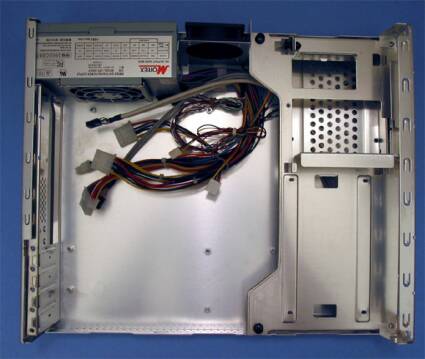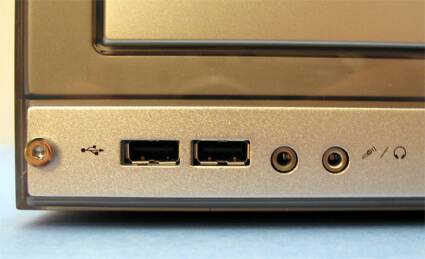2003 Winter Case Review Part 1: MicroATX Case Madness
Super Flower/TTGI - TT-103, Continued
We literally fought with this case for more than twenty minutes to try to dislodge the top of the case from the bottom of the chassis in order to get a look inside. SuperFlower/TTGI needs to attach simple directions for case removal, or enthusiasts are going to "flood" the product support telephone lines with questions as to how to remove the top from the chassis. No matter what we tried, we could not seem to determine the answer to this problem. As with products that supply less than ample documentation, it was a "weird" comedy of trial and error, where we removed every single screw and still could not budge the case apart. After a significant amount of pulling and pushing and an exchange of many swear words, the case finally came apart. It opened easily once we figured out HOW to open it: remove two very inconspicuous screws located in the rear of the chassis, just above the I/O plate. These two screws hold the entire case together. Once they are removed, the case then opens easily for access. This case would be a good test case for a "stump the computer experts" contest!
While the TT-103 is targeted primarily toward the desktop market, the TT-103 can be used in a tower configuration when utilized with the included case stand.
A look at the inside configuration of the TT-103.
With the TT-103's lightweight aluminum construction, the case itself utilizes three plastic fasteners which dislodge the bay from the case to allow for mounting of the devices to your MicroATX motherboard of choice. Due to the configuration and sizes of this case, this was the most "cramped" of cases that we examined in this review. Because of the power supply and side vented configuration of the TT-103, cable routing is both important so as not to restrict airflow, and difficult due to the constricted quarters in which you must work. We found, as with the removal of the top panel from the case, that routing the cables in the best manner possible for best airflow was difficult.
The quality of the case construction itself was very good; however, the case did exhibit some bend and a little twist, which is normal for some aluminum chassis. Still, it was a quality construction that is more than adequate.
A close up of the well-labeled front I/O configuration of the TT-103. We really liked the elegant front bezel design of the TT-103, but unfortunately the rest of the case didn't live up to our expectations.
Get Tom's Hardware's best news and in-depth reviews, straight to your inbox.
Current page: Super Flower/TTGI - TT-103, Continued
Prev Page Super Flower/TTGI - TT-103 Next Page Super Flower/TTGI - TT-103, Continued
